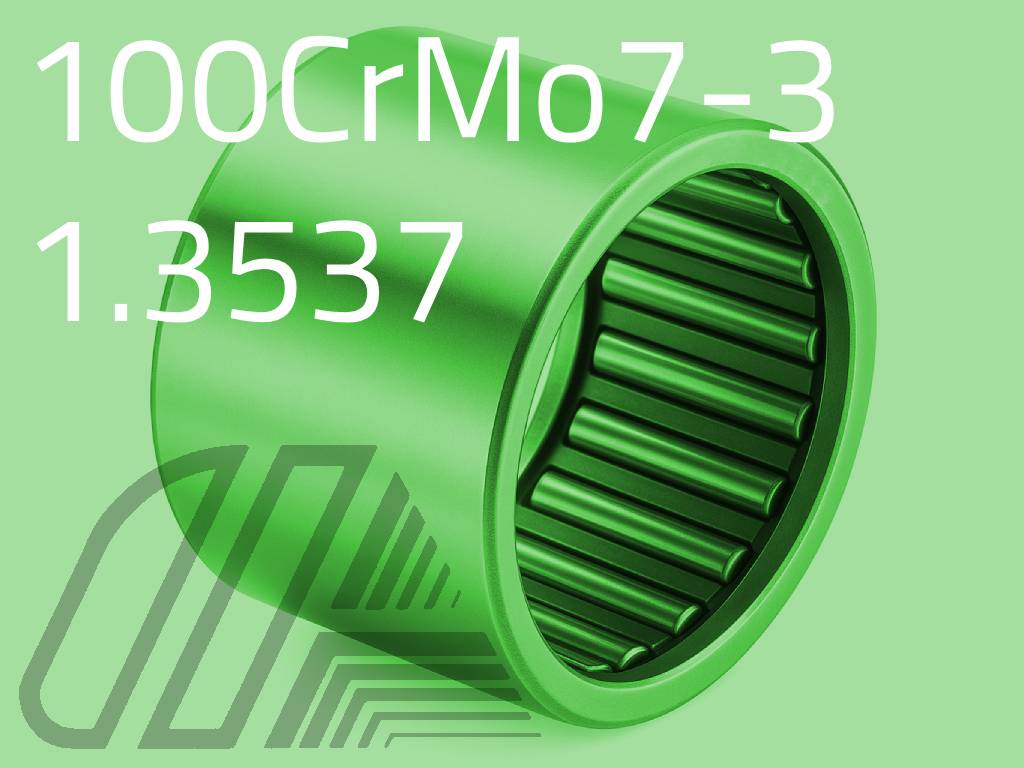100CrMo7-3 (1.3537)
EN ISO 683-17
Globular Annealed (+AC)
PROPERTIES AND EMPLOYEMENTS
100CrMo7-3 steel stands as a critical material in industrial applications, particularly in the realm of bearing manufacturing. Its significance is underscored by its common usage alongside 100Cr6 for the production of bearings across a spectrum of dimensions, from small to large. This steel is recognized for a suite of advantageous characteristics, including a notable resistance to alteration over time under normal operating conditions, exceptional resistance to wear when hardened and stress-relieved, and favorable machinability when subjected to globular annealing. These attributes render it highly suitable for the construction of medium and large bearings, as well as small and medium-sized rollers intended for cold rolling processes and tools designed for cold processing applications.

The mechanical behavior of 100CrMo7-3 steel is heavily influenced by the heat treatment it undergoes. In its soft annealed state, the steel typically exhibits a maximum Brinell Hardness (HB) of around 217 HB , although some sources indicate a potential maximum of 240 HB. This softer condition facilitates machining operations. However, for its primary applications, the steel is typically hardened and tempered to achieve high strength and wear resistance. After hardening and tempering, the surface hardness can reach approximately 62 HRC , with typical values around 61 HRC for martensitic hardening. The tensile strength in the spheroidized annealed condition might range from 460 to 700 MPa, while in the quenched and tempered state, it can reach up to 2300 MPa, depending on the specific tempering temperature.
100CrMo7-3 it is a prime choice for the fabrication of bearings, both of small and large dimensions. Its suitability extends to medium and big bearings , as well as small and medium rollers used in cold rolling processes. The steel is also employed in the production of tools designed for cold processing operations. Specifically, it is well-suited for heavy rings and rollers exceeding 50 mm in effective thickness. Beyond bearings and tools, 100CrMo7-3 finds use in various machine components that demand a high degree of tensile strength, hardness, and toughness. Examples of specific bearing components include ball bearings, rollers, and rings. This wide array of applications, from precision instruments to heavy industrial machinery, underscores the material's versatility and its ability to perform under a variety of demanding conditions. The use in cold rolling rollers and cold processing tools further emphasizes the importance of its high hardness and wear resistance in applications involving significant contact stresses and abrasion.
Similar alloys include EN 1.3537 (100CrMo7) and EN 1.3538 (100CrMo7-4) , as well as the BSI/AFNOR designation K 19965. The existence of these multiple designations facilitates international trade and standardization efforts, allowing for easier identification and procurement of the material across different regions.
CORRESPONDENCE TO INTERNATIONAL DESIGNATIONS
| QUALITY | EUROPE | GERMANY | FRANCE | SPAIN | G.B. | USA | |
|---|---|---|---|---|---|---|---|
| EN | DIN | W.n. | AFNOR | UNE | B.S. | AISI/SAE | |
| 100CrMo7-3 | 100CrMo7-3 | 100CrMo7-3 | 1.3537 | 100CrMo7.2 | F1313 | ||
CHEMICAL COMPOSITION % (EN ISO 683-17)
| STEEL DESIGNATION | CHEMICAL COMPOSITION | ||||||||||
|---|---|---|---|---|---|---|---|---|---|---|---|
| SYMBOLIC | GHOST | C | Si | Mn | P max | S max | Cr | Ni max | Mo | Cu max | Ni + Cu max |
| 100CrMo7-3 | IIIX20M-B | 0,93 ÷ 1,05 | 0,15 ÷ 0,35 | 0,60 ÷ 0,80 | 0,025 | 0,015 | 1,65 ÷ 1,95 | 0,25 | 0,20 ÷ 0,35 | 0,30 | 0,040 |
CONCENTRATION LIMITS OF THE ELEMENTS THAT ARE NOT INDICATED IN THE TABLE CAN BE DEDUCED IN THE EN 10020 REGULATION.
USUALLY AVAILABLE EX STOCK
| M.T. COLORATION | QUALITY | HEAT TREATMENT | SURFACE | DIAMETER (mm) |
|---|---|---|---|---|
 |
100CrMo7-3 | globular annealed | rolled rolled turned/ forged turned |
105-185 190-300 |






